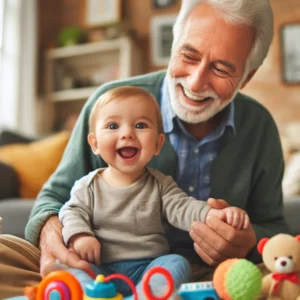
The Role of Baby Babble in Early Speech Development
As a speech therapist and proud grandparent, witnessing the incredible journey of language development firsthand has been a joy. My 6-month-old grandson, Jack, constantly fascinates me with his vocal exploration. One captivating phenomenon in his communication journey is what I lovingly call “babble windows.”
The Science Behind Baby Babble
Imagine Jack sitting quietly, engrossed in his toys, when suddenly, a delightful eruption of squeals, vowels, and consonant sounds fills the room. These spontaneous vocal interludes appear and disappear quickly, leaving behind adorable gibberish. While easy to dismiss as random, these babbling episodes are key to nurturing early communication abilities.
When babies like Jack babble, coo, or squeal, they embark on a thrilling vocal discovery adventure. They explore their voice’s vast potential, test different sound combinations, and lay the groundwork for future speech production. Each adorable raspberry, popped syllable, or nonsensical utterance is a step toward mastering communication.
How to Respond to Babble Windows
Research in speech-language pathology shows that babbling plays a crucial role in paving neural pathways for coordinated speech production. As babies practice making sounds, their brains are exposed to a wealth of auditory and sensory input. This exposure helps them learn to replicate noises intentionally, gradually associating sounds with meaning and setting the stage for conversational ability.
As a grandparent and caregiver, I’ve learned to keep a keen eye and ear out for these fleeting “babble windows.” They can occur at any moment, often when you least expect them. I might be in the middle of a task when suddenly, I’ll hear Jack’s distinct squeal, signaling a prime opportunity for speech interaction. Dropping everything and responding quickly is essential because these windows of vocal willingness can disappear as swiftly as they appear.
The Importance of Intentionality in Early Communication
Engaging with Jack during these precious moments is a delightful dance of reciprocal vocal play. I maintain eye contact, mimic his sounds, and provide encouraging facial expressions and body language. This level of attentive response to his vocalizations promotes what speech therapists call “intentionality” – it motivates Jack to continue refining his vocal control with a communicative purpose. He realizes that his sounds have the power to summon reactions and engage others in meaningful exchange.
Through these babbling dialogues, I’m not only nurturing Jack’s blossoming communication skills but also strengthening our bond. The joy and connection we experience during these impromptu vocal sessions are unparalleled. I’ve noticed that Jack is less fussy and more content when he feels heard and understood on a primal level. It’s a beautiful reminder that communication is about more than just words; it’s about the love, attention, and affection we convey through our interactions.
Strengthening Bonds Through Babbling
As Jack continues to grow and develop, I know that these early babbling experiences will serve as a foundation for his future language abilities. By seizing the opportunity to engage with him during these magical “speech windows,” I’m helping to lay the groundwork for more advanced communication skills. And while the journey of language development is filled with countless milestones and challenges, these heartwarming moments of mutual understanding through babble play make it all worthwhile.
As parents and caregivers, it’s essential to recognize the importance of these “babble windows” and make the most of them when they arise. While it can be challenging to balance our daily responsibilities with the unpredictable nature of these vocal interludes, the benefits of prioritizing these moments are immeasurable.
Practical Tips for Parents and Caregivers
When babies babble, it’s their way of exploring language. Here’s how you can support them:
- Join in the Fun: Mimic their sounds and make eye contact. Show them you’re listening and interested.
- Encourage Them: Smile, nod, and use positive body language to affirm their efforts.
- Be Patient: Babbling might seem random, but it’s essential for learning. Give them time to explore their vocal skills.
- Create a Safe Environment: Make sure they feel comfortable and supported during these vocal experiments.
- Reinforce Connections: Respond to their babbles with enthusiasm. This helps them link sounds to meanings and encourages more vocal play.
Benefits of Babbling
- Builds Communication Skills: Babies learn that their sounds can get a response, which motivates them to keep trying.
- Strengthens Bonds: Engaging in babble sessions creates a deep emotional connection.
- Enhances Development: Each babble is a step towards forming words and sentences.
Remember, these moments are fleeting. Seize the opportunity to connect and support your baby’s language journey every chance you get.
Conclusion
In conclusion, unlocking the power of baby babble for communication development is a simple yet profound way to support language development. Recognizing and seizing these “speech windows” lays the foundation for effective communication and meaningful connections. Let the babbling begin, and cherish every magical moment along the way!
